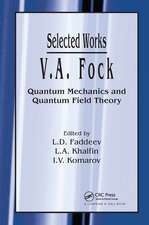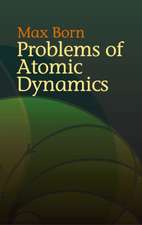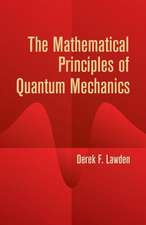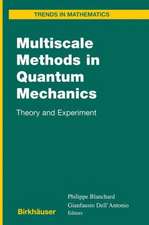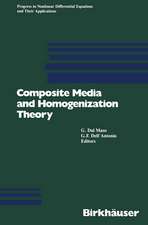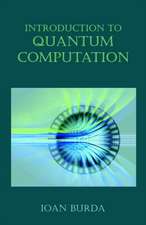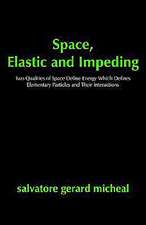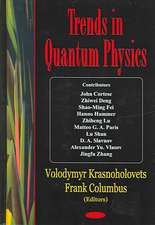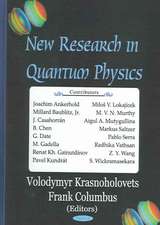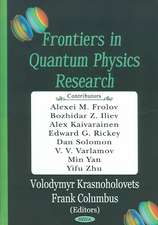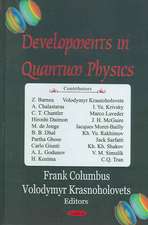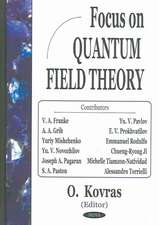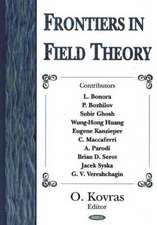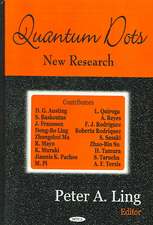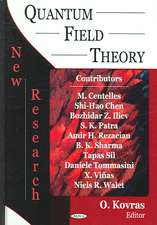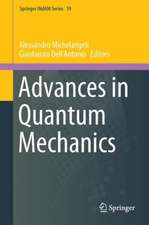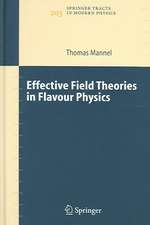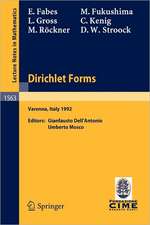Lectures on the Mathematics of Quantum Mechanics I: Atlantis Studies in Mathematical Physics: Theory and Applications, cartea 1
Autor Gianfausto Dell'Antonioen Limba Engleză Hardback – 9 iun 2015
The second part (Selected Topics) are lecture notes of a moreadvanced course aimed at giving the basic notions necessary to do research in several areas of mathematical physics connected with quantum mechanics, from solid state to singular interactions, many body theory, semi-classical analysis, quantum statistical mechanics. The structure of this book is suitable for a second-semester course, in which the lectures are meant to provide, in addition to theorems and proofs, an overview of a more specific subject and hints to the direction of research. In this respect and for the width of subjects this second volume differs from other monographs on Quantum Mechanics. The second volume can be useful for students who want to have a basic preparation for doing research and for instructors who may want to use it as a basis for the presentation of selected topics.
Preț: 796.13 lei
Preț vechi: 970.89 lei
-18% Nou
Puncte Express: 1194
Preț estimativ în valută:
152.35€ • 160.20$ • 125.88£
152.35€ • 160.20$ • 125.88£
Carte tipărită la comandă
Livrare economică 16-30 aprilie
Preluare comenzi: 021 569.72.76
Specificații
ISBN-13: 9789462391178
ISBN-10: 9462391173
Pagini: 325
Ilustrații: XXI, 459 p.
Dimensiuni: 155 x 235 x 35 mm
Greutate: 0.85 kg
Ediția:2015
Editura: ATLANTIS PRESS
Colecția Atlantis Press
Seria Atlantis Studies in Mathematical Physics: Theory and Applications
Locul publicării:Paris, Netherlands
ISBN-10: 9462391173
Pagini: 325
Ilustrații: XXI, 459 p.
Dimensiuni: 155 x 235 x 35 mm
Greutate: 0.85 kg
Ediția:2015
Editura: ATLANTIS PRESS
Colecția Atlantis Press
Seria Atlantis Studies in Mathematical Physics: Theory and Applications
Locul publicării:Paris, Netherlands
Public țintă
ResearchCuprins
Elements of the history of Quantum Mechanics I.- Elements of the history of Quantum Mechanics II.- Axioms, states, observables, measurement, difficulties.- Entanglement, decoherence, Bell’s inequalities, alternative theories.- Automorphisms; Quantum dynamics; Theorems of Wigner, Kadison, Segal; Continuity and
generators.- Operators on Hilbert spaces I; Basic elements.- Quadratic forms.- Properties of free motion, Anholonomy,
Geometric phase.- Elements of C ∗-algebras, GNS representation,
automorphisms and dynamical systems.- Derivations and generators. K.M.S. condition. Elements of modular structure. Standard form.- Semigroups and dissipations. Markov approximation.- Quantum dynamical semigroups I.- Positivity preserving contraction semigroups on C ∗-algebras.- Conditional expectations.- Complete Dissipations.- Weyl system, Weyl algebra, lifting symplectic maps.- Magnetic Weyl algebra.- A Theorem of Segal.- Representations of Bargmann, Segal, Fock.- Second quantization.- Other quantizations (deformation, geometric).
generators.- Operators on Hilbert spaces I; Basic elements.- Quadratic forms.- Properties of free motion, Anholonomy,
Geometric phase.- Elements of C ∗-algebras, GNS representation,
automorphisms and dynamical systems.- Derivations and generators. K.M.S. condition. Elements of modular structure. Standard form.- Semigroups and dissipations. Markov approximation.- Quantum dynamical semigroups I.- Positivity preserving contraction semigroups on C ∗-algebras.- Conditional expectations.- Complete Dissipations.- Weyl system, Weyl algebra, lifting symplectic maps.- Magnetic Weyl algebra.- A Theorem of Segal.- Representations of Bargmann, Segal, Fock.- Second quantization.- Other quantizations (deformation, geometric).
Recenzii
“QM has also been the source of many interesting mathematical problems and developments to which only very few books devote careful attention and discussion. One of the praiseworthy merits of Dell'Antonio's book is to present a comprehensive and updates account of such important mathematical results. … For these reasons the book qualifies as a must for the education of mathematical physics graduate students and clearly provides very useful information also for theoretical physicists as well for mathematicians.” (Franco Strocchi, zbMATH 1357.81001, 2017)
“This is a huge book on the mathematical foundations of quantum theory, including both non-relativistic quantum mechanics (QM) and quantum field theories (QFT). … the specialized reader will find in the book a very nice reference for checking concepts and ways of proceedingsin these domains. It is a remarkable book.” (Décio Krause, Mathematical Reviews, May, 2016)
“This is a huge book on the mathematical foundations of quantum theory, including both non-relativistic quantum mechanics (QM) and quantum field theories (QFT). … the specialized reader will find in the book a very nice reference for checking concepts and ways of proceedingsin these domains. It is a remarkable book.” (Décio Krause, Mathematical Reviews, May, 2016)
Textul de pe ultima copertă
The first volume (General Theory) differs from most textbooks as it emphasizes the mathematical structure and mathematical rigor, while being adapted to the teaching the first semester of an advanced course in Quantum Mechanics (the content of the book are the lectures of courses actually delivered.). It differs also from the very few texts in Quantum Mechanics that give emphasis to the mathematical aspects because this book, being written as Lecture Notes, has the structure of lectures delivered in a course, namely introduction of the problem, outline of the relevant points, mathematical tools needed, theorems, proofs. This makes this book particularly useful for self-study and for instructors in the preparation of a second course in Quantum Mechanics (after a first basic course). With some minor additions it can be used also as a basis of a first course in Quantum Mechanics for students in mathematics curricula.
The second part (Selected Topics) are lecture notes of a moreadvanced course aimed at giving the basic notions necessary to do research in several areas of mathematical physics connected with quantum mechanics, from solid state to singular interactions, many body theory, semi-classical analysis, quantum statistical mechanics. The structure of this book is suitable for a second-semester course, in which the lectures are meant to provide, in addition to theorems and proofs, an overview of a more specific subject and hints to the direction of research. In this respect and for the width of subjects this second volume differs from other monographs on Quantum Mechanics. The second volume can be useful for students who want to have a basic preparation for doing research and for instructors who may want to use it as a basis for the presentation of selected topics.
The second part (Selected Topics) are lecture notes of a moreadvanced course aimed at giving the basic notions necessary to do research in several areas of mathematical physics connected with quantum mechanics, from solid state to singular interactions, many body theory, semi-classical analysis, quantum statistical mechanics. The structure of this book is suitable for a second-semester course, in which the lectures are meant to provide, in addition to theorems and proofs, an overview of a more specific subject and hints to the direction of research. In this respect and for the width of subjects this second volume differs from other monographs on Quantum Mechanics. The second volume can be useful for students who want to have a basic preparation for doing research and for instructors who may want to use it as a basis for the presentation of selected topics.
Caracteristici
Lecture notes in quantum mechanics Advanced course on quantum mechanics Mathematical approach to quantum mechanics Course for advanced students in physics and mathematics Includes supplementary material: sn.pub/extras


